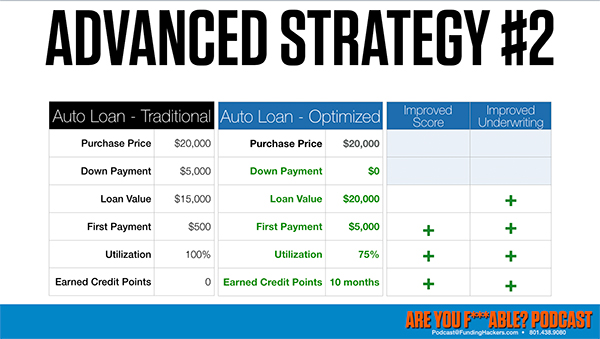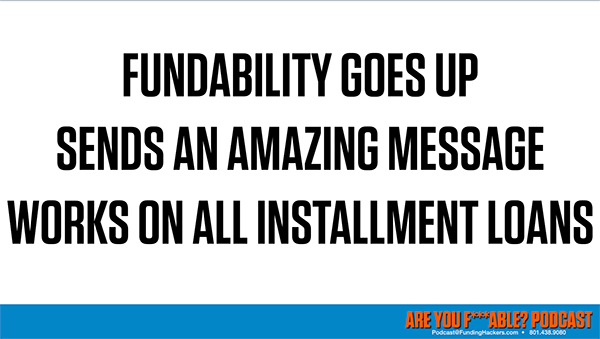
Do you want to be a Rockstar borrower? In this episode, Merrill Chandler continues his discussion on installment loans. He points out that using the rules of the game can show lenders that you are a superstar borrower. Comparing traditional auto loans, he shows how choosing the right lending schemes can contribute to your fundability™. He also shares scenarios that exemplify these loans and how you can make current and future lenders proud. Listen to this episode to know more about game-changing loan strategies, loan value, utilization, and satisfying FICO reports.
—
Watch the episode here
Listen to the podcast here
Game-Changing Loan Strategies
How Your Installment Loans Tell Lenders You Are a Rockstar Borrower
In this episode, we’re going to finish our section on installment loans and how they tell lenders that you are a straight-up rockstar borrower. Let’s take a look at what I mean by that. In this strategy, let’s compare a traditional auto loan. Let’s take a look at some parts of a traditional auto loan. Don’t worry about the numbers, just pay attention to how it contributes to your fundability™ and what you’re up against and how we’re going to make this work. First, let’s say the purchase price is $20,000. We got our income tax back. We think we’re awesome. Aunt Mabel gave us the disbursement in the family. Let’s say we have $5,000 to put down as our down payment. Next, the loan value is $15,000. $20,000 minus the down payment, our loan values are going to be $15,000. We make our first payment of $500 and our utilization is at 100% because the utilization is the balance in relation to the loan amount or in revolving account cases, the limit. Our utilization is 100% and our earned credit points are a big fat zero. Remember, they’re not even going to start counting our points as we learned in the previous episode. They’re not even going to start counting our points until month six. We get jacked for having this loan.
I do put a caveat in there. If this is your first auto loan, it does trigger, “I’ve got an auto loan, a component of FICO’s scoring.” Lender underwriting software does not weigh as heavily the mortgage and auto loan. They leave that to FICO but FICO says, “You get 10 to 20 points for having an auto loan.” We’re not talking about those. We’re talking about the value of the loan not that it fills out a part of the mixed category from FICO. I want to be clear there. Let’s look at an optimized scenario. The optimized purchase price is the same, it’s still $20,000 but this time we’re not going to put anything down. We’re going to say we’re doing zero down payment. Something I’d like to throw out to you is that this is important to understand. We’ve talked about the value of the Toyota motor credit, Ford motor credit, all of those different finance companies and that they’re tier four finance companies. They’re the ones who offer the 0% financing because they’re originally equipment financiers. They’re financing your equipment or their equipment that you’re buying. That’s what the car is.

In that case, you’ll notice there is never a zero interest offered without there also being a rebate offered. At current rates, that rebate is almost always a Grade A credit paper that is going to be the equivalent of what the money you would save on the interest for that term loan. I never take the 0% financing from that lender. It’s Toyota motor credit, Ford motor credit, that’s a finance company. I never take that financing. I take the rebate which is the equivalent of the interest costs for that zero-interest loan. I go get my own financing from a tier one, tier two lender, as we always talk about in the show. Going back, we have a $20,000 limit at our price point, no down payment. That gives us a $20,000 loan value. There’s not a lot of difference here, but I’m trying to teach the principle. This loan is more valuable than this loan to the threshold markers of FICO and the lender underwriting. It’s a more valuable loan. We show over here, improved score and improved underwriting. We get a big fat plus for having that higher loan value.
The next thing we do is instead of making down payment, we take that money or we take the tax return and we make the first payment. We don’t use it as a down. We make the first payment using that same $5,000. What that does is it improves our score and it improves our underwriting because what happens is immediately on that first payment, utilization, in this instance, turns to 75% instead of 100% from a traditional down payment auto loan model. That 75% is the message that you want to send to your current lender and to future lenders. What does it say to your current lender? It’s saying, “I treat your money with deference and respect. I want to make sure that you know that I’m serious about our financial relationship. I am going to lower the utilization so that if something were to happen, you have more likelihood of getting your money back if for some reason were to fail you in our relationship.”
When you know the rules, you will have amazing opportunities to win the game #GetFundable Share on XThat’s what you tell to your current lender, the lender who is carrying the paper on your car. What you tell future lenders is when they review your borrower profile. When they pull your profile, there are markers, part of the FICO and/or part of the lender underwriting software, that’s going to look for the ratio between payments and utilization which means if you’re making one payment per month then you get no bonus points and no penalties. You’re keeping your agreement and if that’s all you want, it’s fine by me. Why I call this an advanced strategy is that in that first month, now it can happen on the first month, second month, third month. The point of this is to get ahead of the payment modality in your monthly payments. Meaning, if I do this on my first payment, I’m going to have 75%. Every single payment I make thereafter, I’m ahead significantly of that amount. You don’t want to do too much in advance because you want the loan to last at least 24 months because that’s where you get the most amount of juice, keeping a loan open for 24 months. You also want to keep it above 50%.
This number needs to stay above 50%. Using this strategy, you drop $5,000 as the first payment and then make your regular monthly payments. By the end of 24 months, you’re above 50% in the balance and you are able to refinance, renew or release. We get better score points and we get better underwriting by using this model. Here’s what’s awesome. If the payment is $500 a month, that $5,000 represents ten months’ worth of points. Remember, you don’t even get credit until month six. You get not only the credit for the month six, where they say yes, but you have also been dependable on for six months and they’re not taking those points away from you. You also have four additional months that are ahead on the first payment. This is groundbreaking. When you know the rules, you can win this game. The second you know what a lender is looking for, you can play strategically to reinforce them and make it killing on points’ fundability™ and your value to that lender.

They will put you in the game and give you the ball if you score every single time you get the ball. Here, your stats go up but you’re making them so proud to have you on their team. This is one of the most amazing strategies and it works for every single installment loan. Your fundability™ screams through the roof. It sends an amazing message to your current lender as well as future lenders. It works on installments. Somebody asked me at a bootcamp, does this work on the home loans? I have a client, this was a couple of years ago and he said he was going to pick up another property and he was going to put 30% down. I said, “I have an idea. Check this out. What if you’re to put 20% down so you get rid of the PMI and all the insurance and hit all the underwriting guidelines so you have the best loan possible? What if you were to take that last 10% and make it as your first payment? Would the numbers still work for you?” Here’s something I’m going to tell you and I vet my lenders accordingly. We may have an episode about this not very long concepts, so it’s not going to take up the 10, 15 or 30 minutes but there’s what’s called re-amortizing your loan.
Some people say, “I’m making a larger payment because it’s $20,000 instead of a $15,000 loan.” What I teach my clients and what I’m going to recommend to you is you find and work with only those banks who will take that first payment of $5,000 and then re amortize the loan. You can get credit as though it were put as your down payment. If you re amortize that loan, they will lower the payments and yet you get to keep the utilization. You have to find those lenders and work with those lenders. There are amazing opportunities when you know the rules of the game. This was quick, but so important. I wanted to focus an entire episode on it because without this information, you can do this with mortgages as I shared with you with auto loans. You can do this with your Winnebagos and any recreational vehicle, your student loans, personal loans, grand piano loans. Whatever loan you get, you can use this strategy and seriously, it will kick its ass. Fundability™ goes through the roof and the message you send the lenders, especially if you do this multiple times. Imagine your entire installment loan portfolio, all the 4 to 5 that are open are all ahead of the payment schedule. Your utilization is more than the payment schedule would be calculated on an even monthly basis. You look like a credit funding god or goddess. I’ll leave with that. Be well.
Love the show? Subscribe, rate, review, and share!





google
April 4, 2020 4:53 amVery energetic article, I enjoyed that bit. Will there be a part 2?